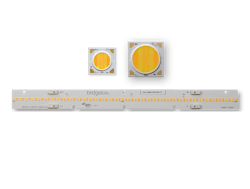Bridgelux has announced an expansion of its Vesta family of LEDs and modular light engines with new white-point-tunable models integrating the Thrive spectral power distribution (SPD) technology that has been shipping in fixed-CCT LEDs. The new solid-state lighting (SSL) devices will presumably deliver white light that more closely mimics the SPD of the sun in the human visual range while also supporting tuning across either the 2700K–65000K-CCT range or the 2700K–5000K-CCT range.
We have covered the Thrive concept a number of times starting with the introduction at LEDucation in 2019. The LEDs utilize dual blue pumps at different blue wavelengths to spread the blue-region spectral energy. The result is minimization of the blue peak found in most phosphor-converted white LEDs and a more uniform SPD.
Existing metrics, however, didn’t fully capture the subtlety of the Thrive technology. The Thrive LEDs scored well in CRI or TM-30 ratings. But the performance was mostly on par to the top-quality LEDs from other vendors. So just a few weeks ago, Bridgelux announced the Average Spectral Difference (ASD) metric that relates LED performance relative to reference illuminants considered to be representative of natural light.
Moving to the Vesta family, that portfolio has been well established and has won recognition in the LEDs Magazine Sapphire Awards as a finalist multiple times and was a winning entry in 2018. Bridgelux refers to the entire portfolio as its chip-on-board (COB) products although the products span what we typically refer to as COB LEDs — the round fried-egg looking components — and rectangular modules that we would call a light engine. Both do share the fact that LED chips are mounted directly on substrates thus the Bridgelux decision to refer to them as a COB line.
Going back to 2018, Bridgelux offered multi-channel, white-point tuning in the Vesta family. Now they are adding the Thrive SPD technology that will generate more natural light and consequently better ASD scores. The announcement includes 9- and 13-mm round COB LEDs with output to 2000 lm, and linear light engines as long as 1120 mm. The products will have typical ASD of 11% at 2700K and 8% at 6500K. CRI and TM-30 scores will all be just shy of 100.
Of course, the question remains as to how Bridgelux accomplished the addition of Thrive technology across the COB products. It appears that the linear products use what are essentially mid-power LEDs with alternating warm- and cool-CCT components. Those components may be the exact same mid-power LEDs with dual blue pumps sold under the Thrive brand. The round COB LED also have readily apparent stripes of warm- and cool-CCT phosphor. We’d suspect that blue pumps with different wavelengths are mixed right on the substrate. We have asked for confirmation from the company.
In any event, Bridgelux is doing everything it can to help product developers accelerate time-to-market for tunable and high-quality SSL products. The company has multi-channel drivers and networked controls that can be easily combined with the COB products.
“Bridgelux is a committed technology partner, ready to help our customers navigate the transition to human-centric lighting,” said Tim Lester, CEO of Bridgelux. “The combination of our Thrive and Vesta Series products constitutes a unique solution tailored for natural, human-centric lighting. A total solution, also incorporating our Vesta Flex driver and controls products, enables rapid integration of this exciting new technology, accelerating the development of differentiated market leading products.”
For up-to-the-minute LED and SSL updates, why not follow us on Twitter? You’ll find curated content and commentary, as well as information on industry events, webcasts, and surveys on our LinkedIn Company Page and our Facebook page.






